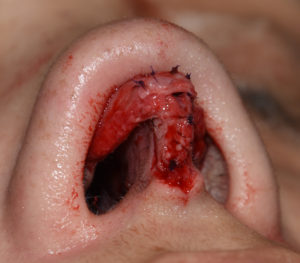Rhinoplasty surgery is an osteocartilaginous operation, meaning changes are made to the bone and cartilage supporting structures. Ultimately the final aesthetic results is in how these changes are done and how much they show through the overlying skin as it shrinks and contracts around the reshaped nasal framework.
Such osteocartilaginous framework changes can be done through removal (reductive) or addition (augmentation) changes and many rhinoplasties contain an assortment of both types of changes. This ie best illustrated in the nasal tip where certain areas of cartilage are removed (e.g., cephalic alar resection), reshaped (dome suturing) or augmented. (cartilage tip grafting)
Nasal tip grafting with cartilage has been extensively done since the widespread adoption of the open rhinoplasty approach. It is performed for a wide variety of reasons including changing tip projection and/or rotation as well as creating greater tip refinement.

While the largest use of cartilage grafting in the tip is the columellar strut graft to provide support and/or increase tip projection, smaller grafts can be used to refine the tip shape. Such grafts can come from a variety of sources such as the remnants of a cephalic lower alarm cartilage trim or from a remaining septal graft harvest. Applying the grafts with small 6-0 resorable sutures allows for good graft security while minimizing the size of the overlying knots.
Dr. Barry Eppley
Indianapolis, Indiana



